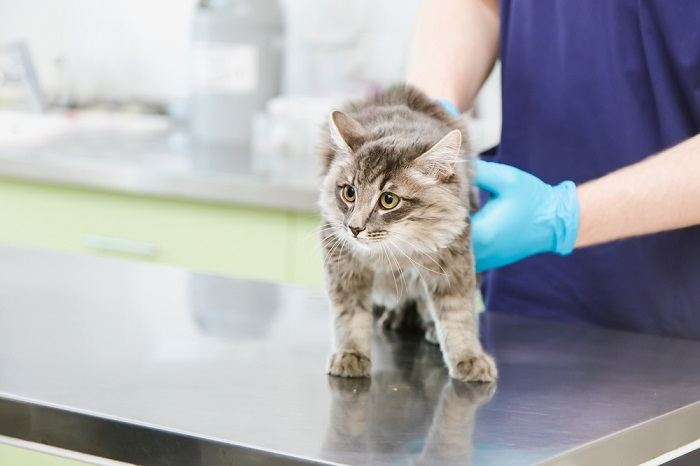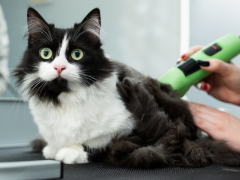
If you share your home with a feline friend or two, you might find yourself tearing your hair out over cat shedding. Unfortunately, when you take on a furry family member, you don’t just get the love, fun, and friendship. You’re also joining the club of cat owners facing a lifetime battle to remove cat hair from their home!
But is there anything you can do to reduce the amount of fur your cat sheds? Does anything really work?
Why Do Cats Shed So Much?

Cat shedding is entirely normal and necessary. After all, the hairs grow and shed in cycles, and the dead hair has to come away. By the same token, some breeds of cats are more likely to shed fur than others.
Also Read: 23 Interesting Facts About Cat Fur You May Not Have Known
So, if you own a Persian, a Ragdoll, or even a British Shorthair, you should expect more shedding than your average cat. However, poor nutrition, lack of grooming, stress, and certain health conditions can make your cat’s coat shedding worse.
When Is Shedding Season for Cats?
Cats typically experience shedding seasons in the spring and fall. In spring, they shed their heavier winter coats to prepare for warmer weather, and in fall, they shed their lighter summer coats to make way for a thicker winter coat. However, some indoor cats exposed to artificial light may shed consistently throughout the year.
9 Steps to Minimize Shedding in Cats
You’ll never stop your cat from shedding altogether, and longhaired cats are likely to shed significantly more than short-haired cats. However, a few things might help reduce the amount of cat hair to a more manageable level.
1. Take Them For A Vet Check

If your cat suddenly starts shedding a lot, schedule a checkup with your veterinarian.
It’s normal for cats to shed their fur, and they may lose more hair at certain times of the year when the seasons change. However, suppose there is any drastic change in the amount of fur your cat is losing. In that case, they should be checked by a veterinarian.
Also Read: Hair Loss In Cats: Causes, Symptoms, & Treatment
This is especially important if you notice them developing bald spots or patches of thin fur. Health conditions like stress, skin allergies, and overgrooming can cause hair loss, so your vet can check for these underlying health problems.
2. Brush Them Regularly

Frequent brushing is the best way to keep shedding under control.
Brushing your cat regularly will remove loose hairs before they find their way to the sofa, carpet, or other soft furnishings. This doesn’t just help stop them from shedding hair around your house, though. It might stop them from bringing up hairballs after grooming.
It also helps prevent the build-up of dead skin cells, yeast, and bacteria, which will keep the skin and coat more healthy. Of course, not every cat likes or even tolerates being brushed, so it’s best to make it a part of their routine from a young age if you can. If you own an adult cat who won’t tolerate brushing, start slowly and use plenty of treats and positive reinforcement as a reward.
Also Read: Best Cat Grooming And Deshedding Gloves
If you don’t have the time to commit to the amount of brushing your cat needs, you could book them a regular slot at the groomer.
3. Reduce Stress

Excessive shedding can be a symptom of stress in cats.
Have you ever visited the vet with your cat companion and found that they cover the examination table with hair? Don’t worry; your vet will be used to this because stressed cats release their fur.
Also Read: 5 Visual Signs Of A Stressed Cat And How To Help
That’s not to say they’ll end up bald, but they will lose significant amounts of hair. By reducing sources of stress and using a calming spray or diffuser, you could see a real difference in the amount of cat hair in your home.
4. Check Their Diet

A high-quality cat food can help maintain healthy skin and coat, reducing shedding.
A well-balanced diet is essential for your purry pal’s health, and this includes their skin and fur. To have a glossy and healthy coat, cats need good quality protein in their diet and sources of essential fatty acids, vitamins, and minerals.
Also Read: 15 Best Cat Foods For Shedding
Poor nutrition can lead to a sparse, poor-quality coat, and may lead to shedding. Therefore, you should make sure that you feed your cat a good quality, nutritionally complete cat food.
5. Improve Their Hydration

Staying hydrated is essential to your cat’s overall health, and may help control shedding too.
Making sure your cat drinks plenty of water could help to keep their coat healthy and reduce shedding. Water drinking fountains and wet food are both good ways to increase your cat’s water intake.
6. Look Into Supplements

Certain supplements may help improve skin and coat health.
Even if your cat’s diet is nutritionally complete, some extra supplements could improve their coat quality and might improve shedding. Ask your veterinarian about supplements like cod liver oil, evening primrose oil, and fish oils.
Some combined skin supplements are also available, containing omega-3, fatty acids, and vitamins like vitamin E. The healthier your cat’s skin and fur are, the less excessive shedding will occur.
7. Treat Fleas

Keep your cat on a year-round flea preventive to keep them from scratching.
If your cat has fleas, their skin will be inflamed and their coat damaged. While this might mean they shed more fur, it might also mean that you find more clumps of fur around the house due to overgrooming and scratching.
8. Use A Furminator Or Rake Brush

Deshedding tools can help remove more hair than brushing alone.
If you’re unfamiliar with a rake or undercoat brush, it might just be the answer you’re looking for. These unusual brushes are designed to remove the dead undercoat.
Also Read: 11 Best Cat Brushes & Deshedding Tools For Long & Short Haired Cats
Dog owners often use them for grooming their canine companions, but they can be just as useful for cats. However, it’s important not to overdo it when using a rake brush. Be gentle, and keep an eye out for skin redness, inflammation, or signs that your cat is uncomfortable.
9. Consider Turning Down The Central Heating

If your cat is shedding a lot in winter, consider how warm you’re keeping the thermostat.
We all know that many animals shed their fur seasonally as the weather gets warmer. However, if you enjoy a warmer than average home and have the central heating on regularly, you might find that this causes your cat to shed more fur.
Of course, there’s no need for you to wear four extra jumpers and a blanket! But, if you can tolerate turning the heating down slightly, you might find your home is easier to keep fur-free.
What Helps with Cat Shedding Naturally?
To help reduce cat shedding naturally, ensure your cat has a balanced diet rich in omega-3 and omega-6 fatty acids, which promote healthy skin and fur. Regular grooming, such as brushing your cat’s coat, can also help manage shedding by removing loose fur. Additionally, keeping your cat hydrated and minimizing stress can contribute to a healthier coat and reduced shedding.
Also Read: Low Shedding Cats Breeds
Removing cat fur from your home can seem like a full-time job, especially if you have a heavy-shedding breed like a Birman or Maine Coon. However, if you’re looking for ways to give yourself a break from the lint roller, try some of the tips above. Failing that, if cat shedding is really bothering you, you could always get a hairless breed like the Sphynx!
Frequently Asked Questions
Why is my indoor cat shedding so much?
Indoor cats may shed more fur because they’re in a warmer environment. As long as they have no patches of thin hair or baldness, and the amount of shedding hasn't changed, it's probably normal. It's also worth remembering that if your cat never goes outside, all their shed fur will be in your home. You might even find clumps of hair in areas of the house where they often groom themselves. Regular brushing is the most effective way to reduce the amount of hair they shed.
Does brushing a cat help with shedding?
Brushing your cat’s fur won't mean they shed less, but it will mean that a lot of the hair will be on the brush rather than in your home. In fact, brushing your cat is essential, especially if they are old and arthritic or longhaired. Brushing doesn't just reduce the cat hair in your home. It also keeps your favorite feline's skin and coat healthy and prevents mats.
Can you overbrush a cat?
Brushing your cat can sometimes loosen the dead skin cells and oils and move them through the coat. This can give the appearance of a greasy, scurfy coat. Although this looks worse temporarily, it’s actually beneficial. However, if you brush your cat too much or with a particularly abrasive brush, you might cause skin irritation, redness, and inflammation.
How do you keep shedding to a minimum?
Shedding is very normal for cats, but if you're concerned that your cat is shedding more than usual, you should take them to a vet. Ensuring they have a good diet, brushing them regularly, reducing stress, and giving supplements can help keep your kitty's hair loss to a minimum.






